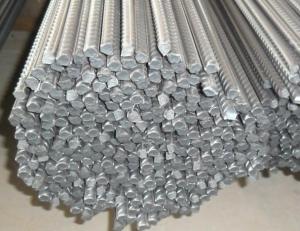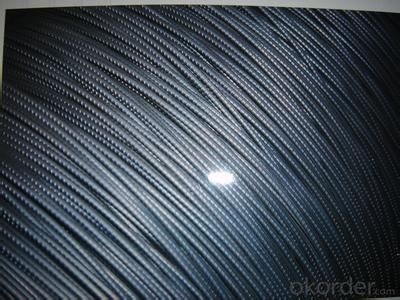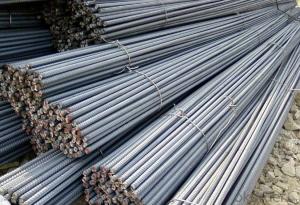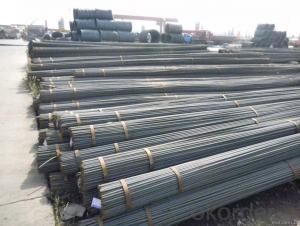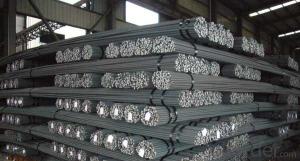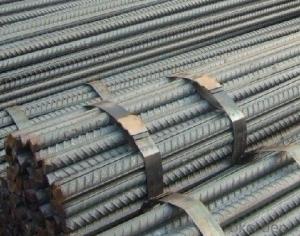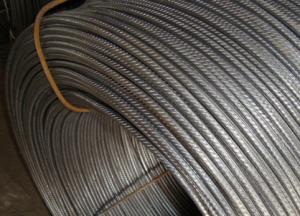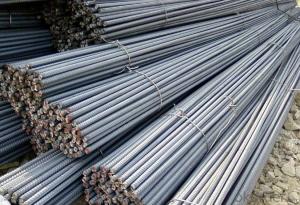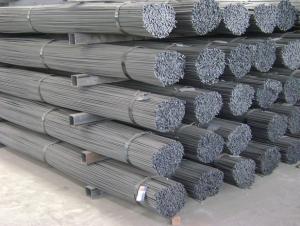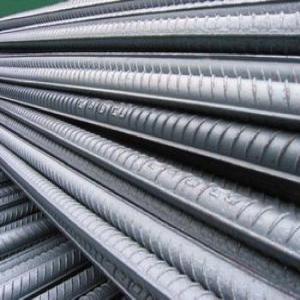Cold Rolled Steel Rebars with High Quality 6mm-50mm
- Loading Port:
- Tianjin
- Payment Terms:
- TT or LC
- Min Order Qty:
- 50 m.t.
- Supply Capability:
- 15000 m.t./month
OKorder Service Pledge
OKorder Financial Service
You Might Also Like
Specifications of Cold Rolled Steel Rebars with High Quality 6mm-50mm:
Name | Cold Rolled Steel Rebar | |
Diameter | 6mm,8mm,10mm,12mm,14mm,16mm,18mm,20mm, 22mm,25mm,28mm,32mm,36mm,40mm,50mm | |
Length | 6M, 9M,12M or as required | |
Price | Keep lower operating costs so as to offer competitive price for our clients | |
Label | to be specified by customer, generally, each bundle has 1-2 labels | |
Application | Building, construction | |
Invoicing | Actual or Theoretical Weight Basis as buyer’s request. | |
Theoretical weight and section area of each diameter of Cold Rolled Steel Rebars with High Quality 6mm-50mm as below for your information :
Diameter(mm) | Section area (mm²) | Mass(kg/m) | Weight of 12m (kg) | Pcs/ton |
6 | 28.27 | 0.222 | 2.664 | 375.38 |
8 | 50.27 | 0.395 | 4.74 | 210.97 |
10 | 78.54 | 0.617 | 7.404 | 135.06 |
12 | 113.1 | 0.888 | 10.656 | 93.84 |
14 | 153.9 | 1.21 | 14.52 | 68.87 |
16 | 201.1 | 1.58 | 18.96 | 52.74 |
18 | 254.5 | 2.00 | 24 | 41.67 |
20 | 314.2 | 2.47 | 29.64 | 33.74 |
22 | 380.1 | 2.98 | 35.76 | 27.96 |
25 | 490.9 | 3.85 | 46.2 | 21.65 |
28 | 615.8 | 4.83 | 57.96 | 17.25 |
32 | 804.2 | 6.31 | 75.72 | 13.21 |
36 | 1018 | 7.99 | 98.88 | 10.43 |
40 | 1257 | 9.87 | 118.44 | 8.44 |
50 | 1964 | 15.42 | 185.04 | 5.40 |
Packaging & Delivery of Cold Rolled Steel Rebars with High Quality 6mm-50mm:
Packaging Detail: products are packed in bundle and then shipped by container or bulk vessel, deformed bar is usually naked strapping delivery, when storing, please pay attention to moisture proof. The performance of rust will produce adverse effect.
Each bundle weight: 2-3MT, or as required
Payment terms: TT payment in advance or Irrevocable LC at sight.
Trade terms :FOB, CFR, CIF
Delivery Detail: within 45 days after received advanced payment or LC.
FAQ:
Q1: Why buy Materials & Equipment from OKorder.com?
A1: All products offered byOKorder.com are carefully selected from China's most reliable manufacturing enterprises. Through its ISO certifications, OKorder.com adheres to the highest standards and a commitment to supply chain safety and customer satisfaction.
Q2: How do we guarantee the quality of our products?
A2: We have established an advanced quality management system which conducts strict quality tests at every step, from raw materials to the final product. At the same time, we provide extensive follow-up service assurances as required.
Q3: How soon can we receive the product after purchase?
A3: Within three days of placing an order, we will arrange production. The shipping date is dependent upon the quatity, how many sizes you want and the plan of production, but is typically 1 month to 2 month days from the beginning of production.
Images of Cold Rolled Steel Rebars with High Quality 6mm-50mm:
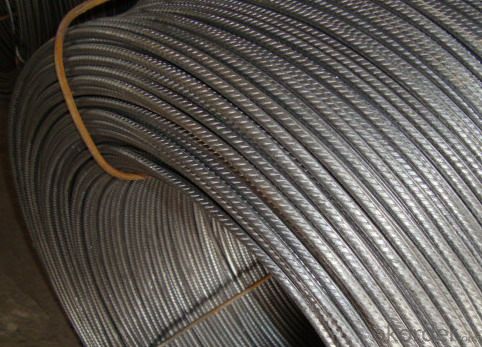

- Q: What are the guidelines for proper storage and transportation of steel rebars?
- The guidelines for proper storage and transportation of steel rebars include keeping them off the ground to avoid moisture and corrosion, storing them in a well-ventilated area, organizing them in a neat and stable manner to prevent falling or shifting, protecting them from direct exposure to weather conditions, and securing them properly during transportation to avoid damage or accidents.
- Q: Can steel rebars be used in residential swimming pool construction?
- Yes, steel rebars can be used in residential swimming pool construction. Steel rebars provide structural reinforcement to the pool walls and floor, ensuring stability and durability.
- Q: How do steel rebars affect the overall structural stability of a building?
- Steel rebars significantly enhance the overall structural stability of a building. By reinforcing concrete, rebars increase its tensile strength and prevent cracking and failure under heavy loads or external forces. This reinforcement ensures that the building can withstand various stresses, such as earthquakes, wind, and vibrations, improving its durability and safety.
- Q: What are the guidelines for proper spacing and lapping of steel rebars in concrete structures?
- The guidelines for proper spacing and lapping of steel rebars in concrete structures vary depending on the specific design and structural requirements. However, some general recommendations exist. The rebars should be adequately spaced to ensure proper concrete cover, allowing for corrosion protection and sufficient bond strength. Typically, the minimum spacing between parallel rebars is around 1.5 times the diameter of the larger bar or 25 mm (1 inch), whichever is greater. Lapping, or overlapping, of rebars is necessary to create a continuous load path. The length of the overlap depends on the design and the type of rebar connection being used. It is important to follow the specifications provided by structural engineers and adhere to local building codes to ensure the proper spacing and lapping of rebars in concrete structures.
- Q: Are steel rebars suitable for use in foundation structures?
- Yes, steel rebars are suitable for use in foundation structures. They provide strength and reinforcement to concrete, enhancing its load-bearing capacity and durability. Steel rebars are commonly used in foundation construction due to their high tensile strength and ability to withstand heavy loads and stress.
- Q: What are the guidelines for protecting steel rebars during concrete placement and compaction?
- The guidelines for protecting steel rebars during concrete placement and compaction include ensuring that the rebars are clean and free from any rust, grease, or other contaminants. They should be properly tied and supported to maintain their position and prevent displacement during the concrete pouring process. Additionally, rebars should be adequately spaced to allow concrete to flow around them and provide sufficient cover, as specified in the design requirements. Care should be taken to avoid damaging the rebars during compaction, and vibrating equipment should be used cautiously to prevent excessive force or vibration that could cause rebars to shift or become dislodged. Regular inspections should be conducted to check for any damage or movement of the rebars, and necessary repairs or reinforcement should be done promptly to ensure the structural integrity of the concrete.
- Q: How are steel rebars tested for quality and strength?
- Steel rebars are tested for quality and strength through a series of standardized tests. These tests ensure that the rebars meet the required standards and can withstand the expected loads and stresses. One common test is the Tensile Test, which measures the maximum amount of stress a rebar can withstand before it breaks. In this test, a sample rebar is pulled until it fractures, and the force required to break it is measured. This test provides valuable information about the rebar's ultimate tensile strength, yield strength, and elongation. Another important test is the Bend Test, which evaluates the rebar's ductility and ability to withstand bending without breaking. In this test, a sample rebar is bent to a specific angle, and any cracks or fractures are closely examined. The rebar is deemed acceptable if it doesn't show any signs of failure. Additionally, Chemical Analysis is performed to determine the chemical composition of the rebar. This test ensures that the steel meets the required chemical composition standards, as different compositions can affect the rebar's strength and durability. Furthermore, the Dimensional Test checks the dimensions, weight, and shape of the rebar to ensure they comply with the specified standards. Any deviations from the required measurements can compromise the rebar's structural integrity. Moreover, the rebar's Surface Condition is examined visually to assess any signs of rust, cracks, or other defects that may affect its performance. Proper surface condition is crucial as it ensures good bonding with the surrounding concrete. Finally, some rebars undergo Non-Destructive Testing such as ultrasonic testing or magnetic particle inspection to detect any hidden defects or cracks that may not be visible to the naked eye. Overall, these testing methods are employed to ensure that steel rebars have the required quality and strength to be used in construction projects, providing the necessary reinforcement for reinforced concrete structures.
- Q: How do steel rebars contribute to the overall ductility of a structure?
- Steel rebars contribute to the overall ductility of a structure by providing reinforcement and enhancing its ability to withstand deformations and absorb energy without failure. The addition of rebars in concrete structures improves its tensile strength, as concrete alone is weak in tension. This combination allows the structure to flex and bend under loading, reducing the risk of brittle failure and increasing its overall resilience.
- Q: How are steel rebars classified based on grades?
- The strength of steel rebars is determined by their grade, which is based on their minimum yield strength. Steel rebars are classified into different grades to indicate their ability to withstand stress and loads. Grade 40, Grade 60, and Grade 75 are the most commonly used grades for steel rebars. Grade 40 rebars have a minimum yield strength of 40,000 psi and are typically used in general construction projects where high strength is not the main requirement. They are suitable for light to moderate load-bearing structures such as residential buildings, sidewalks, and driveways. Grade 60 rebars, with a minimum yield strength of 60,000 psi, are the most widely used for construction purposes. They can be applied in a wide range of applications and are commonly used in reinforced concrete structures, bridges, highways, and commercial buildings. Grade 60 rebars provide the necessary strength to withstand heavy loads and seismic forces. Grade 75 rebars, with a minimum yield strength of 75,000 psi, are designed for high-stress applications. They are mainly used in large-scale infrastructure projects, including high-rise buildings, dams, and heavy industrial structures. Grade 75 rebars offer exceptional strength and durability, making them suitable for projects that require superior load-bearing capacity and resistance to extreme conditions. It is important to note that the specific requirements and standards for steel rebars may vary among different countries and regions. Therefore, it is crucial to adhere to local codes and regulations to determine the appropriate grade of steel rebar for each construction project.
- Q: Are steel rebars suitable for use in industrial facilities?
- Steel rebars are an excellent choice for industrial facilities due to their high suitability. They are commonly employed in construction projects to reinforce concrete structures, and their strength and robustness make them ideal for environments that experience heavy loads and high stress. By utilizing steel rebars, the structural integrity and load-bearing capacity of the facility are enhanced, ensuring its ability to withstand the demands of industrial operations. Moreover, steel rebars demonstrate exceptional resistance to corrosion, which is particularly important in industrial settings where exposure to moisture, chemicals, and other corrosive substances is prevalent. In conclusion, steel rebars offer the necessary durability, strength, and corrosion resistance required for reinforcing concrete structures in industrial facilities, making them a suitable choice.
Send your message to us
Cold Rolled Steel Rebars with High Quality 6mm-50mm
- Loading Port:
- Tianjin
- Payment Terms:
- TT or LC
- Min Order Qty:
- 50 m.t.
- Supply Capability:
- 15000 m.t./month
OKorder Service Pledge
OKorder Financial Service
Similar products
Hot products
Hot Searches
Related keywords
